Hornworm. That is all.
Close-up of a Sphinx Moth caterpillar. Green. Giant. Loves chile plants. (photo A.Shock)
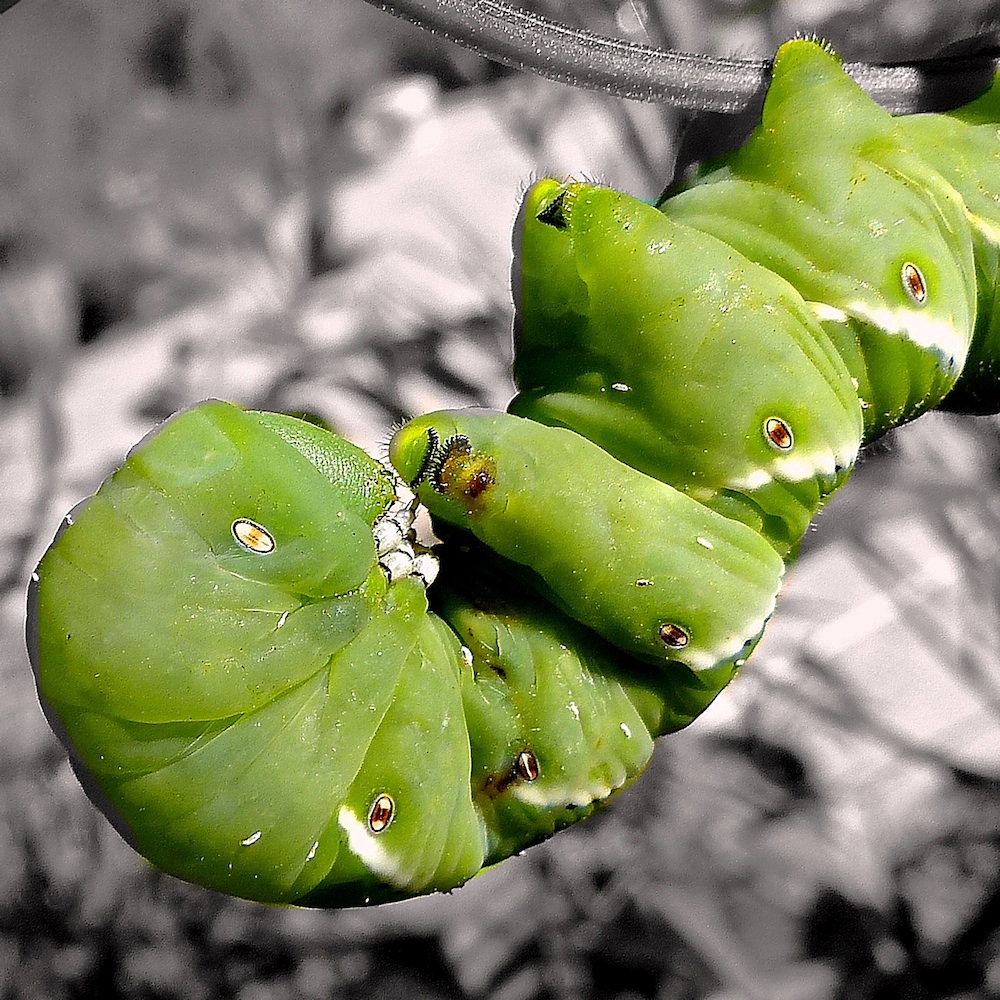
Close-up of a Sphinx Moth caterpillar. Green. Giant. Loves chile plants. (photo A.Shock)

Big excitement around here yesterday! While looking for a Mockingbird that had been singing loudly all morning but was anomalously out of sight, I found a thrilling visitor in our yard: a Long-Eared Owl. It was perched in our back yard acacia tree, just about 9 or 10 feet up. It wasn’t hard to see, once my eyes had accidentally fallen upon it. Despite the thin screening of fine foliage it was relying on for coverage, the blue sky behind gave away its owliness (see photos below).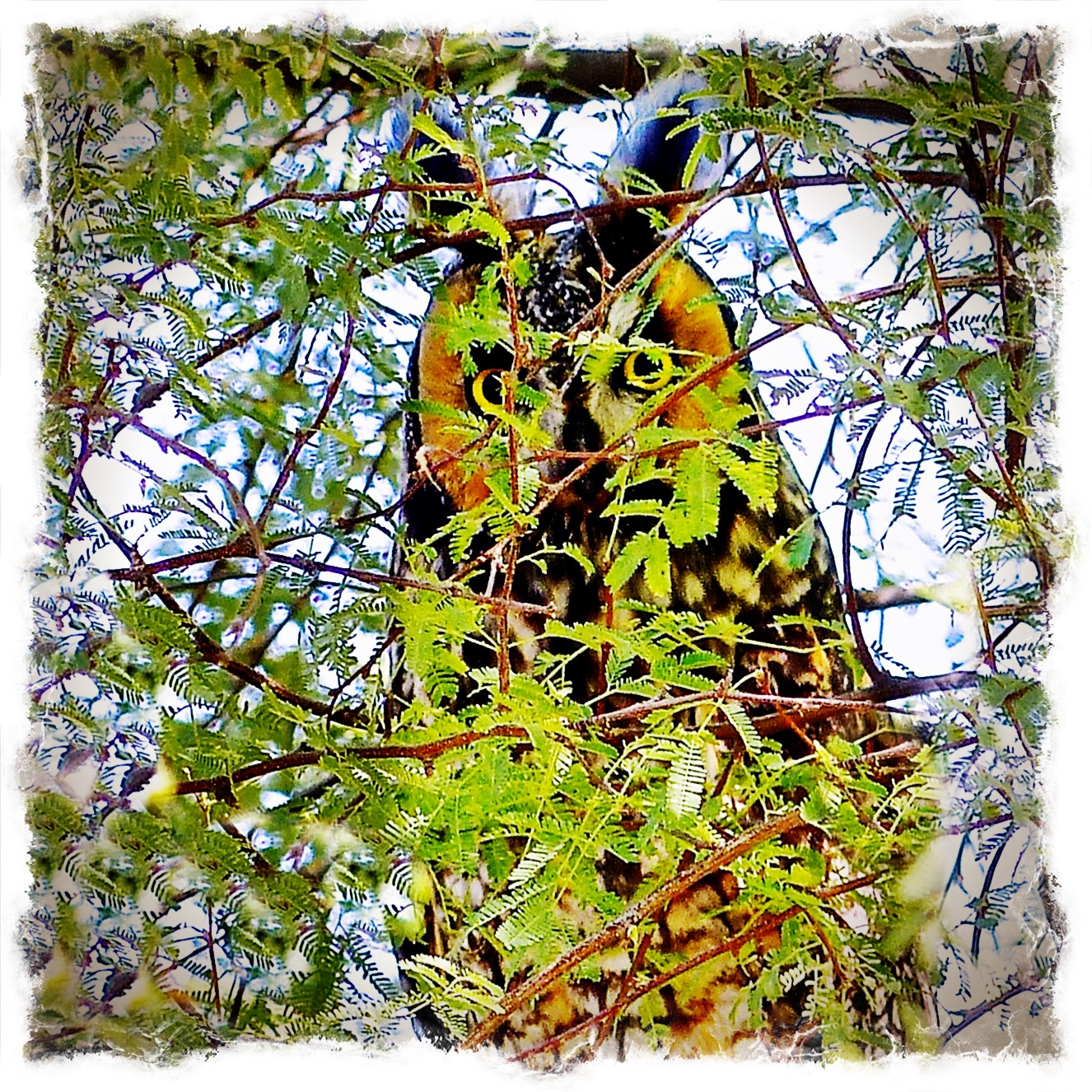
Long-Eared Owls are not something you see every day. It’s not because they’re rare in the Western U.S., people just don’t spot them very often.
>> Artsy edit of yesterday’s owl, keeping an eye on me keeping an eye on it. Very thankful for a long lens, so I didn’t have to get too close! (photo A.Shock)
This is because for the most part, they’re very hidey creatures, even for owls. Good camo — including spectacular “ear” tufts that are more centrally located and longer relative to its head than those of Screech Owls or Great Horned Owls, plus a bark-like bar-spotted belly pattern — is one reason Long-Eareds are seldom seen. They have great trust in this camo, and yesterday’s bird showed this confidence. It knew I was looking at it, but it held still and didn’t shift, except to open its eyes briefly. The same strategy of motionlessness worked on the local songbirds as well. They knew it was there — I saw lots of them come in to check it out, woodpeckers, hummers, finches, thrashers — but their behavior and vocalizations never became anything as frenzied as a “mob”. The owl sat quietly, and the scene didn’t escalate. I’ve seen Cactus Wrens and Verdins pitch bigger fits over an Elf Owl, a bird which is a fraction of the size of the Long-Eared.
It spent the afternoon dozing and swivelling its head occasionally — I could see it from the safe distance of the back porch, with binoculars — its magnificent cranial tufts wafting slightly in the breeze. At twilight, it spent some time preening, bending its head over its back to align long primaries and tail feathers. At full dark, it gave a raspy bark and flew out into the night.
Like many birders, I’m sometimes asked how to spot an owl. This is one of the best ways: be sure you always look for the Mockingbird. Not literally always a Mockingbird, of course. But one of the biggest joys of birding (or any sort of getting outside activity) is that you may not find what you’re looking for, but there’s always something to see.
And, also: a dark owl shaped blob in a tree is pretty much a dead giveaway!
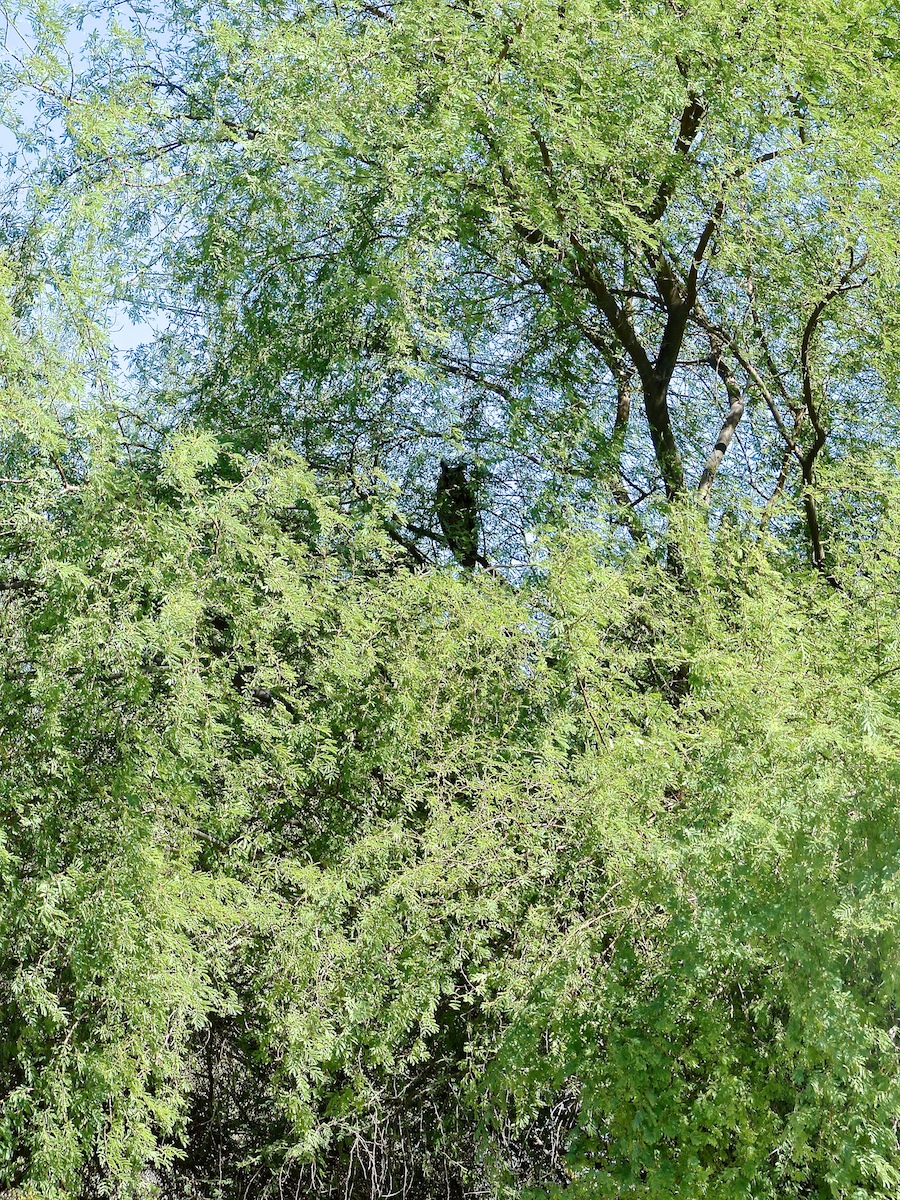 Long-Eared Owls are considered a “medium-sized” owl: bigger than a Screech Owl, but smaller than a Great Horned Owl. If you want to read more about this species, click here.
Long-Eared Owls are considered a “medium-sized” owl: bigger than a Screech Owl, but smaller than a Great Horned Owl. If you want to read more about this species, click here.
For the record, here are a couple of less-tweaked images of the owl in situ. Be sure to click to enlarge! (All photos A.Shock)
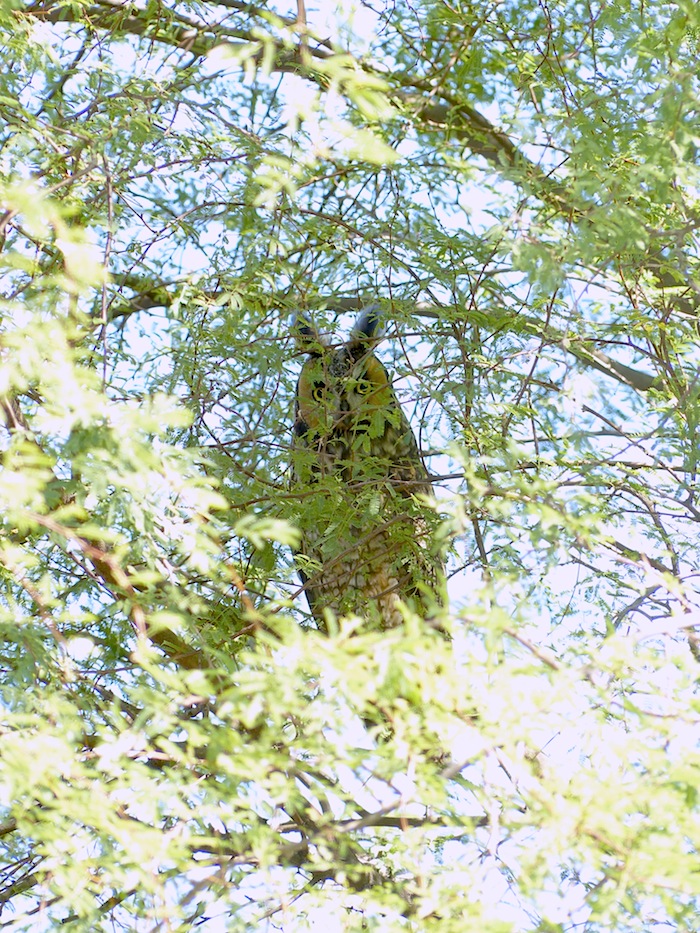
I’ve noticed a pattern. In late September and early October, Spadefoots come out and wander around the yard. Some are small, and look like young of the year. Some are less small, and may be hatched in previous seasons.
Today I noticed an agitation in the pool — my workspace looks over the shallow end — and I went out to check, expecting a lizard. We’ve got a wildlife ramp set up, but not all plunge-victims find it in time, so I always go out to see what’s causing ripples.
It was a fairly well-grown Spadefoot. As I’ve mentioned here in the past, Spadefoots are not technically toads, although you’d never know by looking, or at least I wouldn’t know. Technically, they are “toad-like amphibians”. Or so I’ve read.
Here’s an eye-level shot of today’s TLA (toad-like amphibian)
You’ll just have to imagine me lying on my belly on the gritty pool deck with the end of the macro lens just centimeters off this guy’s nose. I think the proximity of the lens is what accounts for the wacky eye-angle: parallax.
more info
#333300;”>And look at those clutching little fingers — I LOVE toad hands. (Yes they’re not toads, and yes they’re not hands, but you know what I mean). Also, it’s hard to tell where its smile ends — does it wrap all the way around its shoulders like a shawl? Am I in danger of being swallowed? In case you’re wondering, its skin isn’t really blue, but it was in the shade, and the digital process cooled its natural tans and dark olives to the color you see. The eyes, however, really are that shattered-glass golden green. The whole animal is not quite three inches long.
I had to rescue it out of the pool twice, and we’ll have to keep checking the filter basket for a few days. At some point, the Spadefoot will have hunted itself into a state of packing enough stored energy to survive its over-wintering self-interment. Then it’ll dig in somewhere in soft soil to wait for next year’s summer storms, when the thunder will boom it up from the ground to enjoy the moist monsoon nights.
Fall is a second spring in the desert, and things are wandering.
Immature but already full-grown birds hatched this year are making their first migration, or seeking a permanent residence away from the parental sphere. Young mammals, too, are moving to new locations on their own. Some creatures are fanning out looking for mates, such as tarantulas (right) and other arthropods.
Although many make it, this can be a perilous diaspora, and it brings visibly increased mortality along roads as young inexperienced animals or adults driven by an impulse stronger than their understanding of speeding vehicles try to cross busy highways.
In our yard the main hazard — other numberswiki.com
than waiting predators — is the swimming pool. The male sunspider below (possibly Eremochelis bilobatus) fell into the pool sometime during a nocturnal rambling and couldn’t get out. With luck, he’d found a female before he succumbed, and was able to do his part to continue the local population.
People often ask how big they are, so I’ve included my hand for scale. (Click to enlarge to see his bristly glory and fierce mandibles. Both photos, A.Shock). Driven to find out more about Solpugids or sunspiders? Check this website. For the record, taxonomists consider them more closely related to Pseudoscorpions than to spiders.
We had a very hard freeze this past winter, and it took its toll in the garden, killing some plants back to the ground, and seriously nipping others. Spring clean-up is long past, but for some reason (maybe it’s the uncompromised-by-cold thorns on its branches!) we never got around to cutting back the partly-killed bougainvillea that clings to the back porch latilla, despite the disorderly brown leaves and gray stem.
Now it’s too late! This little charmer, a first-year male Costa’s Hummingbird, is holding the withered vine and nearby nectar feeder as his own, and I don’t have the heart to prune his perch. Gaze upon his Adolescentness — he’s just growing in his soon-to-be-glorious purple Yosemite Sam moustachios! He’s fairly fearless, and sat on a twig singing just feet from me, as I was taking macro shots of a poor sun-spider I’d fished moribund out of the pool. When I say “singing” I mean emitting a high, thin “sssseeeee” and spraying the sound all around by holding his bill slightly upward, while moving his head gently back and forth like an electric fan. It’s hardly audible to human ears, but clearly does the trick for the species, as he was recently an egg himself.
First-year male Costa’s Hummingbird (Photo A.Shock)
The top of our neighborhood is a great place to view the impressive dust storms that roll into the Phoenix metro area a few times during each monsoon season. My view is to the south, across Papago Park towards South Mountain. This is the direction the storms often come from, the result of a tall cumulous cloud collapsing in a down-draft blast that kicks up agricultural and desert soils in a shock wave of granular murk. They move fast and arrive with a gust of hot wind and chemical-laden grit. I walked up to Oak street to watch this one come in. (Click on each photo to enlarge. All photos A.Shock).
Here’s what the sky to the south looked like pre-haboob. You can just see the brown glow of the dust cloud low to the left of center, a dirt-colored sliver of sky between the two houses, behind the utility pole. The rest are local gray storm clouds. The low sun is the bright glare on the right:
It only took a few minutes for the javelina-brown snout of the haboob (previous snout here) to reach the metro area. In the photo below, it’s engulfing Sky Harbor airport:
The photo above is looking southwest. The front of the dust cloud stretched to the east as well. Here’s looking towards the east valley just as the edge of the storm reached our neighborhood:
The gray thunderstorm above the dust cloud was biding its time. It brought some ominous cloud-forms along for the ride. If the front edge of the dust is the snout of the Heavenly Javelina, these clouds were hanging down like her teats:
Our part of town was fortunate: just a blast of gritty wind, a smattering of raindrops, some window-rattling lightning, and it was over in half an hour. Other neighborhoods weren’t so lucky: stronger winds downed trees, there were flooded roads, and some lightning strikes that crisped a tree or two.
I haven’t been posting here much recently, due to circumstances.
Circumstances like deadlines, ants, and the fact that I may be about to lose the entire file structure of my photos on the computer as a result of trying to solve the problem of a broken DVD player (a chain of events as obtuse as it sounds) — all the standard impediments to writing. So instead of shrieking, I choose to post this photo of an excellent organism we saw yesterday in the skirts of the Pinal Mountains:
You can tell by its spectacular comb-like antennæ that it’s a moth — the imago of a Grapeleaf Skeletonizer (Harrisina sp.). In this adult format, the metallic blue moth is harmless enough, here sipping nectar from a milkweed flower. It will only live a few days, which it will spend mating and laying eggs, which will hatch into beautiful caterpillars that will efficiently denude plants like grapes and virginia creepers of their foliage. Meanwhile, it wants you and any other looming predators to think it’s a wasp and leave it alone — a strategy that works pretty well, until you notice those telltale pectinate antennæ, a dead giveaway for mothliness.
(Photo A.Shock)
The New Camera has enabled me to take shots that the beloved, well-used but limited Old Camera couldn’t handle. Both are pretty good at macro, but zoom is the strength of the new camera. Effective zoom has made it possible for me to get a shot of something I’ve wanted to capture for a long time: the lovely paper wasps who float like little golden sea-planes on the surface of the pool.
Above, Paper Wasp afloat: no pontoons needed — its light body weight, waxy coating, and ability to create floatation cushions under its feet by not breaking surface tension, enable it to bob on the water while it collects mouthfuls to build with — you can see from the surface distortion in the photo above that this wasp has its mouthparts on the water, actively taking it in. Once it’s tanked up, the insect will rise nearly vertically off the surface to fly back to the nest. They almost never swamp, even in the chop I make swimming laps.
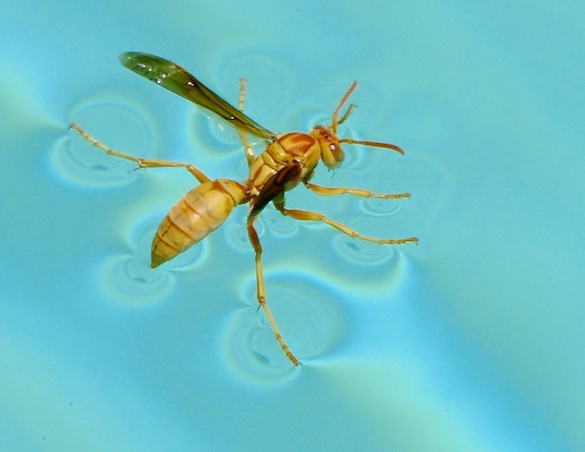 These golden sea-planes are Polistes wasps, commonly called Paper Wasps because of the papery, multi-cellular nests they build. Ours are probably Polistes flavus, but I’d need confirmation from someone who knows more about wasps than I do, to be certain. They seem to be peaceable sorts, and tolerate us moving around their space. In our experience, they’ve never acted aggressively, even once when E was tugging up the dead lemon grass where unbeknownst they’d built their nest. A few of them flew up and out of the fibrous clump. He scampered away, but there was no trouble — none of them even bothered to escort him away from the scene. Paper wasps are good for a garden: the adults drink plant nectar (and hummingbird food) for their own nutrition, but they are tireless predators of small voracious caterpillars and other soft-bodied insects which they prepare by chewing and deliver as food balls to their young waspy larvæ.
These golden sea-planes are Polistes wasps, commonly called Paper Wasps because of the papery, multi-cellular nests they build. Ours are probably Polistes flavus, but I’d need confirmation from someone who knows more about wasps than I do, to be certain. They seem to be peaceable sorts, and tolerate us moving around their space. In our experience, they’ve never acted aggressively, even once when E was tugging up the dead lemon grass where unbeknownst they’d built their nest. A few of them flew up and out of the fibrous clump. He scampered away, but there was no trouble — none of them even bothered to escort him away from the scene. Paper wasps are good for a garden: the adults drink plant nectar (and hummingbird food) for their own nutrition, but they are tireless predators of small voracious caterpillars and other soft-bodied insects which they prepare by chewing and deliver as food balls to their young waspy larvæ.
(Both photos A.Shock — Do click to enlarge, especially the upper one. There’s lots of good detail to be gained, like sparly water drops on its abdomen.)
 In anticipation of a major and photogenic meteorological event, I went out just now to photograph the storm. With the exception of some dramatic skies, the whole mess skipped over us (we need the rain, but I can’t say I miss dust and wind). But I caught something else brooding and unpredictable. It shouldn’t be hard for you to spot it, its eye is partly open. Horizontal napping bark.* (See HNB the first here.) Once you’ve found it, click to enlarge, I’ve uploaded a generous-sized file.
In anticipation of a major and photogenic meteorological event, I went out just now to photograph the storm. With the exception of some dramatic skies, the whole mess skipped over us (we need the rain, but I can’t say I miss dust and wind). But I caught something else brooding and unpredictable. It shouldn’t be hard for you to spot it, its eye is partly open. Horizontal napping bark.* (See HNB the first here.) Once you’ve found it, click to enlarge, I’ve uploaded a generous-sized file.
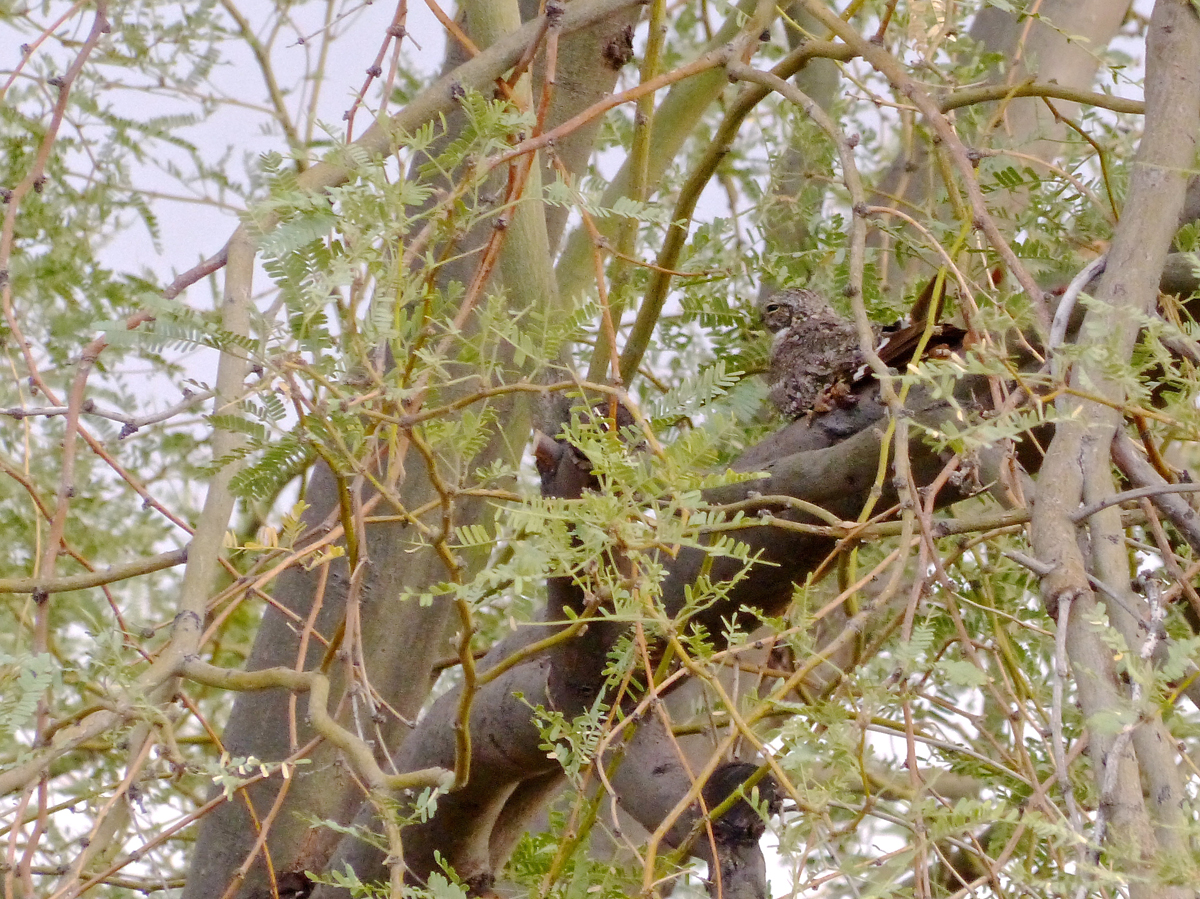 For readers unfamiliar with the group of birds called nightjars, this is a Lesser Nighthawk (Chordeiles acutipennis, a member of the caprimulgid family or goat-suckers, along with Whippoorwills and kin). It’s hunkered parallel to a mesquite branch with its tail pointed at the camera. The bird flew up off the ground as I was watching the sky, did a lap of the neighbor’s yard, and settled on a branch where it will stay until it’s dark enough to launch on an aerial forage. Even though the bird is facing slightly away from the camera and behind some twigs, you can see the distinctive white throat patch, and the white mark on the primaries neatly folded over its tail. This is one of a pair of birds who nested on the gravel of a neighbor’s front yard. In an effort to keep wildlife out, the homeowner created a stir along the block (it’s not a very pretty fence) and also a really good habitat for ground-nesting birds. I look at the unpopular fence a little differently, knowing that a pair of nighthawks has fledged nestlings inside its confines for each of the last three years, at least. (Photo A.Shock)
For readers unfamiliar with the group of birds called nightjars, this is a Lesser Nighthawk (Chordeiles acutipennis, a member of the caprimulgid family or goat-suckers, along with Whippoorwills and kin). It’s hunkered parallel to a mesquite branch with its tail pointed at the camera. The bird flew up off the ground as I was watching the sky, did a lap of the neighbor’s yard, and settled on a branch where it will stay until it’s dark enough to launch on an aerial forage. Even though the bird is facing slightly away from the camera and behind some twigs, you can see the distinctive white throat patch, and the white mark on the primaries neatly folded over its tail. This is one of a pair of birds who nested on the gravel of a neighbor’s front yard. In an effort to keep wildlife out, the homeowner created a stir along the block (it’s not a very pretty fence) and also a really good habitat for ground-nesting birds. I look at the unpopular fence a little differently, knowing that a pair of nighthawks has fledged nestlings inside its confines for each of the last three years, at least. (Photo A.Shock)
*Vertical napping bark would be, of course, an owl. This concept inaugurated the Spot the Bird feature here on Three Star Owl blog.